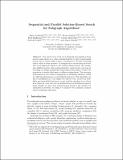Files in this item
Sequential and parallel solution-biased search for subgraph algorithms
Item metadata
| dc.contributor.author | Archibald, Blair | |
| dc.contributor.author | Dunlop, Fraser | |
| dc.contributor.author | Hoffmann, Ruth | |
| dc.contributor.author | McCreesh, Ciaran | |
| dc.contributor.author | Prosser, Patrick | |
| dc.contributor.author | Trimble, James | |
| dc.contributor.editor | Rousseau, Louis-Martin | |
| dc.contributor.editor | Stergiou, Kostas | |
| dc.date.accessioned | 2019-08-12T16:30:02Z | |
| dc.date.available | 2019-08-12T16:30:02Z | |
| dc.date.issued | 2019 | |
| dc.identifier | 259334091 | |
| dc.identifier | 868634c4-0469-4326-8d5f-6f10a1b1d092 | |
| dc.identifier | 85066859617 | |
| dc.identifier | 000884721600002 | |
| dc.identifier.citation | Archibald , B , Dunlop , F , Hoffmann , R , McCreesh , C , Prosser , P & Trimble , J 2019 , Sequential and parallel solution-biased search for subgraph algorithms . in L-M Rousseau & K Stergiou (eds) , Integration of Constraint Programming, Artificial Intelligence, and Operations Research : 16th International Conference, CPAIOR 2019, Thessaloniki, Greece, June 4–7, 2019, Proceedings . Lecture Notes in Computer Science (including subseries Lecture Notes in Artificial Intelligence and Lecture Notes in Bioinformatics) , vol. 11494 LNCS , Springer , Cham , pp. 20-38 , 16th International Conference on the Integration of Constraint Programming, Artificial Intelligence, and Operations Research, CPAIOR 2019 , Thessaloniki , Greece , 4/06/19 . https://doi.org/10.1007/978-3-030-19212-9_2 | en |
| dc.identifier.citation | conference | en |
| dc.identifier.isbn | 9783030192112 | |
| dc.identifier.isbn | 9783030192129 | |
| dc.identifier.issn | 0302-9743 | |
| dc.identifier.other | ORCID: /0000-0002-1011-5894/work/58531618 | |
| dc.identifier.uri | https://hdl.handle.net/10023/18298 | |
| dc.description | Funding: This work was supported by the Engineering and Physical Sciences Research Council (grant numbers EP/P026842/1, EP/M508056/1, and EP/N007565). | en |
| dc.description.abstract | The current state of the art in subgraph isomorphism solving involves using degree as a value-ordering heuristic to direct backtracking search. Such a search makes a heavy commitment to the first branching choice, which is often incorrect. To mitigate this, we introduce and evaluate a new approach, which we call “solution-biased search”. By combining a slightly-random value-ordering heuristic, rapid restarts, and nogood recording, we design an algorithm which instead uses degree to direct the proportion of search effort spent in different subproblems. This increases performance by two orders of magnitude on satisfiable instances, whilst not affecting performance on unsatisfiable instances. This algorithm can also be parallelised in a very simple but effective way: across both satisfiable and unsatisfiable instances, we get a further speedup of over thirty from thirty-six cores, and over one hundred from ten distributed-memory hosts. Finally, we show that solution-biased search is also suitable for optimisation problems, by using it to improve two maximum common induced subgraph algorithms. | |
| dc.format.extent | 19 | |
| dc.format.extent | 1819794 | |
| dc.language.iso | eng | |
| dc.publisher | Springer | |
| dc.relation.ispartof | Integration of Constraint Programming, Artificial Intelligence, and Operations Research | en |
| dc.relation.ispartofseries | Lecture Notes in Computer Science (including subseries Lecture Notes in Artificial Intelligence and Lecture Notes in Bioinformatics) | en |
| dc.subject | Computer Science(all) | en |
| dc.subject | Theoretical Computer Science | en |
| dc.subject | DAS | en |
| dc.title | Sequential and parallel solution-biased search for subgraph algorithms | en |
| dc.type | Conference item | en |
| dc.contributor.sponsor | EPSRC | en |
| dc.contributor.sponsor | EPSRC | en |
| dc.contributor.institution | University of St Andrews. School of Computer Science | en |
| dc.contributor.institution | University of St Andrews. St Andrews GAP Centre | en |
| dc.contributor.institution | University of St Andrews. Pure Mathematics | en |
| dc.identifier.doi | 10.1007/978-3-030-19212-9_2 | |
| dc.date.embargoedUntil | 2020-04-28 | |
| dc.identifier.url | http://eprints.gla.ac.uk/180906/ | en |
| dc.identifier.grantnumber | EP/P026842/1 | en |
| dc.identifier.grantnumber | EP/N007565/1 | en |
This item appears in the following Collection(s)
Items in the St Andrews Research Repository are protected by copyright, with all rights reserved, unless otherwise indicated.

